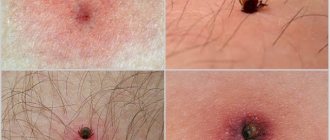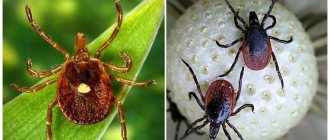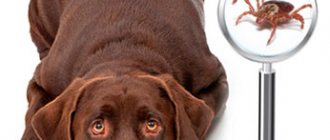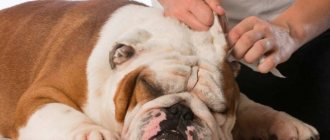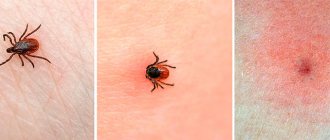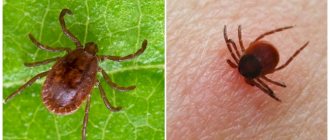Danger of ticks
To properly respond when your pet is attacked by a tick, you need to know some facts about them:
- Ticks go through four stages in their development. Only adults are dangerous for dogs. A nymph may still cling to the puppies.
- In an adult, the head (or rather the cephalothorax) is clearly separated from the abdomen and there are 4 pairs of legs. Nymph - looks like an adult, but has 3 pairs of limbs. If the parasite has already attached itself and drank blood, in appearance it will resemble a large dark mole.
- A hungry tick is brown in color, and when it drinks blood, it acquires a light shade and becomes closer to gray.
- In Russia, the two most common types of ixodid ticks that can be dangerous are the dog tick and the taiga tick. Despite the name “dog” tick, it clings to many species of animals and humans.
The main danger is not the ticks themselves, but the even smaller parasites they carry.
The most common of them:
- Ehrlichia canis - microorganisms that cause ehrlichiosis
- Borrelia burgdorferi is the bacterium that causes canine borreliosis, also known as Lyme disease.
- Babesia canis is a blood parasite (it penetrates red blood cells and destroys them), causing canine pyroplasmosis, or, another name, canine babesiosis.
You will not be able to know for sure whether your pet has been infected or not unless you have the parasite itself tested. In the worst case scenario, until the pet begins to show signs of illness, which may occur in a few weeks.
A tick can become infected through a bite (although the process is more like an injection). He injects his saliva into the bite site, which, in addition to a special substance (painkiller), may contain dangerous microorganisms.
Tick suction occurs as follows:
- with parts of the oral apparatus it cuts the skin and pushes its proboscis there;
- on the proboscis there are several teeth with which the tick is firmly held in the skin; it looks like a saw.
Removal algorithm
If a blood-sucking arachnid is found on your pet, you need to take all measures to remove it immediately; the longer it is on the dog, the higher the risk of infection, inflammation and allergic reactions.
The ideal option would be to contact a veterinary clinic specialist who will quickly and correctly get rid of the pest.
If this is not possible, then you can perform the procedure yourself. To do this, you need to follow the following procedure:
- If the dog does not allow you to touch the affected area due to pain, you should first give an injection of novocaine or spray it with a lidocaine spray;
- For long-haired breeds, it is necessary to cut the coat around the desired area or lubricate it with oil and comb the hair to the side;
- Place the dog under a source of good lighting;
- If the animal is restless, then you should wear a collar or muzzle, and also take care of an assistant who will hold the dog during the procedure;
- Disinfect all removal tools with alcohol or other antiseptic, calcinate metal products;
- Prepare in advance everything that may be useful during the procedure, as well as for subsequent treatment of the wound, since while the owner is distracted, the dog may try to escape;
- Wear gloves, as some diseases can be transmitted to humans;
- Remove the tick according to the chosen method;
- Make sure that all parts of the insect have been removed (abdomen, head, 3 or 4 pairs of legs, depending on the age of the bloodsucker);
- Treat the suction site;
- Take the insect to the laboratory to check for diseases;
- Give the animal an antihistamine, and also monitor its condition (temperature, behavior, skin reactions) - if it worsens, contact a veterinarian to prescribe treatment.
Diseases and symptoms
As already noted, a tick bite can cause serious diseases, the most dangerous of which are:
Piroplasmosis or babesiosis
The most common disease, dangerous for dogs of all breeds and ages. The incubation period is up to two weeks. Symptoms:
- lethargy;
- temperature increase;
- refusal to eat;
- thirst;
- mild jaundice - the mucous membranes become pale, with a yellowish tint;
- at the peak of the disease, the urine becomes dark, sometimes with a red tint;
- diarrhea, yellowish or greenish stool color;
- vomit.
Borreliosis or Lyme Disease
An infectious disease that can affect all systems of the body, because of this, the symptoms in each individual case are very different. The appearance of any symptoms may begin several months after infection!
Ehrlichiosis
An infection that affects several body systems at the same time. The incubation period ranges from several weeks to several years. This disease knows how to wait. First warning signs:
- poor appetite;
- elevated temperature;
- depressed state;
- reluctance to play;
- sudden weight loss;
- vomit;
- diarrhea;
- bruising on the mucous membranes and skin.
None of these diseases can be waited out or cured at home; at the first suspicion, immediately contact a veterinarian!
What signs can be used to determine if a dog has ticks?
In general, the bite of these small bloodsuckers is notorious for being difficult to diagnose, especially on dogs with long hair. The daily life of every owner should include the habit of carefully observing the behavior of their pet and knowing their habits and temperament well.
If you have regular tweezers, they will work fine.
After some time, the affected area of the skin begins to itch. At first, the behavior of the four-legged pet does not change, but a few days after such an “attack” the dog becomes restless and nervous. He often scratches the damaged area. Moreover, for this he does not always use his paws; door jambs, walls and other protruding pieces of furniture and interior are used.
There are also other, more pronounced signs of the presence of a pest:
- increased body temperature;
- decreased activity;
- loss of appetite;
- the white part of the eye becomes yellowish;
- Blood appears in the urine from time to time.
If you have such symptoms, you should definitely contact a specialist. After all, we can talk about the health of the animal.
How to look for ticks on a dog
It is worth examining your pet after every walk. Pay special attention to areas of the body where there is the least hair and it is not long:
- muzzle, especially nose;
- ears, both outside and inside;
- paws. Many people forget to examine the pads and between the toes;
- stomach;
- groin area.
After examining the parasite’s “favorite” places, inspect the neck and back.
Carefully examine each area of the body, parting the fur. Buy a brush - it will be much more convenient for your dog to use a comb.
This routine procedure of examining your dog from the tip of his nose to the tip of his tail can save your pet's life. After all, this is the only way to detect a tick in time, do not neglect it.
Algorithm for removing ticks at home
If you do not have the opportunity to get to the clinic as soon as possible, then you should act at home. To do this, you need to have a device for twisting a tick in your home medicine cabinet. This could be one of the following:
- tweezers. It is better to use with a curved tip;
- special device - twister. The best choice! Veterinary clinics resort to this method;
- thread;
- medical syringe.
Proceed according to the following algorithm:
Prepare scissors, a magnifying glass, a device that will be used to remove the tick, and a jar to close the tick (it must be delivered to the laboratory). Prepare your own gloves!
Secure your dog in a way that is comfortable for both you and him.
It is necessary to trim the hair at the site of the bite.
Further actions depend on the tool you choose.
- If you use tweezers, carefully grasp the tick as close to the head as possible, do not touch the abdomen. The main thing is not to crush the parasite during the procedure! As soon as you have fixed the tick, begin to pull it out, making rotational movements, at the same time twisting and pulling upward.
- If you have a twister, then everything is much simpler - you definitely won’t crush the parasite with it! Grab the tick from the side and pull it up. When you managed to fix it, the principle is exactly the same as with tweezers. Pull it out using a rotational motion, gently pulling the tick upward.
- The method with a thread is not a very good idea, since there is a danger of simply cutting the tick with it. Nevertheless, this is an effective method when there is no special device at hand. Make a loop of thread and use it to tighten the parasite as close to the dog's skin as possible. This way you are most likely to catch the proboscis. Once secured, pull the thread from side to side, as if loosening the little enemy, then carefully pull it out.
- The syringe method doesn't always work, but you can try. You need to close the nozzle of the syringe (without a needle!) on the parasite, so that the syringe is in close contact with the skin; for this you can even lubricate the skin around the syringe with cream. Next, simply pull the piston, creating a vacuum, and the tick will pop out on its own.
After removing the pest, look under a magnifying glass to see if its legs and proboscis are in place. This will ensure that there are no parts of the parasite left in the dog's body. Otherwise, you will have to remove the remains with a needle, or even contact a veterinarian (he will make an incision). If this is not done, inflammation may develop.
Seal the tick in a jar to take to the laboratory.
Treat the bite site with an antiseptic. This can be hydrogen peroxide, chlorhexidine, iodine or an alcohol solution.
All that remains is to deliver the parasite to the laboratory and make sure that everything will be fine with the pet, or start treatment in advance to prevent a severe course of the disease.
Caring for your dog after tick removal
If you manage to rid your dog of ticks yourself, you need to:
- Inspect the wound to see if the arthropod's head remains inside. If so, the area needs to be disinfected and the residue removed with tweezers. If this is not done, there is a risk that an inflammatory process will begin. In this case, it is inconvenient to work with a needle; you can pick the wound too much.
- If the head cannot be removed, the wound is regularly lubricated with iodine. The dog’s body itself will reject the foreign body after some time.
- If the wound is clean, it is treated with any antiseptic: brilliant green, iodine, peroxide, alcohol.
After the parasite is removed, there is no point in immediately taking the dog to the veterinary clinic and removing the tick from the dog for testing. On the first day, protozoa are not detected in the peripheral blood. Therefore, the result of the analysis will be negative, but also false. Accurate results appear within 3-4 days. And even with a negative indicator, a repeat analysis is done on days 5-7.
It is also impossible to determine from the ectoparasite itself whether it is a carrier or not. An infected tick does not look different from a normal tick. Even if he is a carrier, it is not a fact that he was the one who managed to infect the dog.
Females drink the blood of animals. Having sucked, they do this for 5-7 days, inflate and become like a large dark pearl. Then the female falls off her body - she needs to lay eggs in a secluded place to continue the race. Therefore, if a small, newly attached tick is found and the dog develops symptoms of the disease, then the culprit may not be this one, but a completely different specimen that has fallen off long ago. After all, symptoms of infection can appear from 3 to 21 days after the bite. The owner only has to monitor the pet and measure the temperature up to 5 times a day.
The removed tick is destroyed. And it's better to burn it. The fact is that if the female was a carrier of piroplasms, then her offspring will also be infected.
Basic mistakes
A common belief is that the tick must first be doused with oil or nail polish to cut off the oxygen supply, the tick will die and come off on its own.
On the one hand, there is some truth here. The tick actually breathes through its abdomen, and it will actually die if you pour oil on it. Only now he won’t unhook and won’t loosen his grip, but on the contrary! His grip will become stronger and it will be more difficult to reach him. Dying, in a state of agony, it can burrow even deeper into the skin.
And most importantly, during this process he will begin to actively splash saliva inside the dog, and in the saliva of the parasite, as we already know, there are dangerous microorganisms!
Dousing a tick with oil, nail polish or gasoline can only make things worse.
Prevention
The basis of prevention is timely treatment and examination of the dog after each walk. For treatment against external parasites, the most effective modern means are tablets:
Nexgard
Bravecto
Simparica
Drops on the withers are also effective:
Advantix
Frontline
Collars are not very effective and can only be used in combination with other drugs.
What to do after removing a tick?
After removing the parasite, carefully inspect the bite site, since the proboscis could remain in the wound if removed incorrectly. This is dangerous due to inflammation of surrounding tissues and the appearance of pus. Also, the likelihood of a dog becoming infected with the piroplasmosis virus also increases. To remove the proboscis, it is best to contact a veterinarian. If this is not possible, then you can try to remove the tick’s head with a needle. Pre-treat the instrument with a disinfectant solution and remove the proboscis, like a splinter. After removing the tick, the wound is treated with any antiseptic, and the insect itself must be taken to the laboratory for analysis.
For prevention, you need to use special collars, sprays, drops on the withers, tablets. Products are divided into repellent and insecticidal. They differ in the type of effect on parasites and can complement each other. The use of parasite protection significantly reduces the likelihood of a dog being bitten by ticks. Take care of your pet and do not forget to examine it during a walk at least once an hour.
If you find an error, please select a piece of text and press Ctrl+Enter.
Popular questions
What to do if the head comes off and how to get it out?
If the tick's head still remains in the pet's body, it must be removed, otherwise inflammation will begin. This can be done with a needle, although the dog will not like it and, of course, it will break out. If you are unable to restrain your pet and pick out the head of the parasite, it is better to consult a veterinarian. At the clinic, a small incision will be made in your pet and parts of the tick will be removed. There won't even be a scar left on your dog.
How to remove a tick from your ear?
In order to remove the parasite from the animal's ear, you will need good lighting. If we are talking about ixodid ticks, of course, and not about ear ticks, you will never get them. Try to fix the pet as best as possible and follow the algorithm described above. If the pest has climbed deep enough into the ear canal, it is better to contact a veterinarian, otherwise you risk harming your pet.
How to remove a tick from a dog's eye?
The algorithm of actions in this case is no different. There is only one nuance - fixation of the animal. It is unlikely that you will be able to hold your pet and carry out the necessary manipulations alone. After all, no one likes it when someone gets in his eyes; it’s obvious that the dog will try to break free. If you are afraid of accidentally injuring your pet, take him to a veterinary clinic.
If you pulled out a tick, but the dog still has a lump.
There are two options:
- Perhaps, when you took out the bastard, his proboscis still remained under the skin, as a result, we see an inflammatory process, sometimes even with pus. Your action in this case is to contact a veterinary clinic. There, your pet will have the wound examined and parts of the parasite will be removed (an incision may need to be made).
- Another possibility is an allergic reaction. Your pet may have developed an allergy to tick saliva. Usually, a lump caused by an allergy does not cause concern to the animal.
In any case, if you find a lump at the site of the bite, you should consult a veterinarian.
What to do if the dog does not allow you to remove the tick?
If your pet actively resists your actions and does not allow you to remove the parasite, there is only one conclusion - he is in pain. To make the task easier for yourself and calm your pet, locally numb the bite site with an ice-caine solution. There is no need to give the animal a pill and do not inject anything yourself! Just apply the solution to the skin, this action will be enough.
If the tick head remains in the dog
You need to completely remove the tick from your dog. If there is a head left, it must be removed, otherwise it will cause inflammation and suppuration, and subsequently infect the animal. This is done using a sterilized needle. The actions are reminiscent of pulling out a splinter. The head remaining in the skin looks like a black dot. After the procedure, the dog's wound is treated with iodine.
If the head remaining in the skin cannot be seen, the pet should be taken to the veterinarian. He will remove the bloodsucker through a small incision.
After removing the tick head, a small lump may remain at the bite site. It goes away on its own within a few days. The appearance of suppuration at this site requires the intervention of a veterinarian.
Briefly about the main thing
- Ticks are dangerous pests that can carry diseases: piroplasmosis, borreliosis, ehrlichiosis and many others.
- At the first symptoms of illness after a bite, contact your veterinarian immediately. Even if it's just loss of appetite or depression.
- Inspect your pet yourself after each walk, especially the face, paws, belly and groin area.
- Follow the pest removal algorithm and don’t forget about your safety - wear gloves.
- You should not pour oil or other liquids on the tick so that “it will die and fall off on its own.” This does not work.
- After removal, be sure to take the little scoundrel to the laboratory.
- Treat your pet for external parasites in a timely manner.
Have we answered your question fully enough? If not, post your question in the comments below and our veterinarian will answer it.
Did you like the article? Share it with your friends on social media. networks. This will help them get useful information and support our project.
What to do after removing the parasite
- Treat the wound with iodine, brilliant green, hydrogen peroxide or other disinfectant. Do this after removing the proboscis.
- If the tick has been on the dog's body for a long time, wash the animal with shampoo and treat it with an acaricide.
Treatment with an acaricidal agent will help reduce the risk of tick bites - Observe the behavior and well-being of the animal after the bite. If obvious abnormalities appear, contact your veterinarian immediately. This should also be done when the bite occurred during estrus and the dog is preparing for mating. The doctor will conduct the necessary tests to exclude or detect infection.
The doctor will identify the disease in time and prescribe treatment
Advice! Place the extracted tick in a test tube or vial and submit it to the laboratory. The analysis will determine whether the parasite is a carrier of infection.
After removing the tick, place it in a jar and take it to the laboratory


